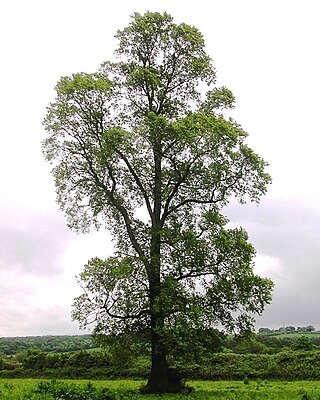
Elms are deciduous and semi-deciduous trees comprising the genus Ulmus in the family Ulmaceae. They are distributed over most of the Northern Hemisphere, inhabiting the temperate and tropical-montane regions of North America and Eurasia, presently ranging southward in the Middle East to Lebanon and Israel, and across the Equator in the Far East into Indonesia.
Melia or Melie may refer to:

Buprestidae is a family of beetles known as jewel beetles or metallic wood-boring beetles because of their glossy iridescent colors. Larvae of this family are known as flatheaded borers. The family is among the largest of the beetles, with some 15,500 species known in 775 genera. In addition, almost 100 fossil species have been described.

A bark beetle is the common name for the subfamily of beetles Scolytinae. Previously, this was considered a distinct family (Scolytidae), but is now understood to be a specialized clade of the "true weevil" family (Curculionidae). Although the term "bark beetle" refers to the fact that many species feed in the inner bark (phloem) layer of trees, the subfamily also has many species with other lifestyles, including some that bore into wood, feed in fruit and seeds, or tunnel into herbaceous plants. Well-known species are members of the type genus Scolytus, namely the European elm bark beetle S. multistriatus and the large elm bark beetle S. scolytus, which like the American elm bark beetle Hylurgopinus rufipes, transmit Dutch elm disease fungi (Ophiostoma). The mountain pine beetle Dendroctonus ponderosae, southern pine beetle Dendroctonus frontalis, and their near relatives are major pests of conifer forests in North America. A similarly aggressive species in Europe is the spruce ips Ips typographus. A tiny bark beetle, the coffee berry borer, Hypothenemus hampei is a major pest on coffee plantations around the world.

The term woodboring beetle encompasses many species and families of beetles whose larval or adult forms eat and destroy wood. In the woodworking industry, larval stages of some are sometimes referred to as woodworms. The three most species-rich families of woodboring beetles are longhorn beetles, bark beetles and weevils, and metallic flat-headed borers. Woodboring is thought to be the ancestral ecology of beetles, and bores made by beetles in fossil wood extend back to the earliest fossil record of beetles in the Early Permian (Asselian), around 295-300 million years ago.
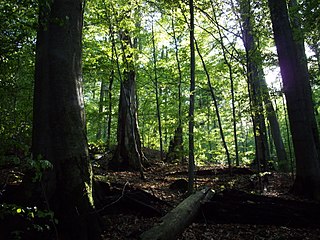
Temperate deciduous or temperate broad-leaf forests are a variety of temperate forest 'dominated' by deciduous trees that lose their leaves each winter. They represent one of Earth's major biomes, making up 9.69% of global land area. These forests are found in areas with distinct seasonal variation that cycle through warm, moist summers, cold winters, and moderate fall and spring seasons. They are most commonly found in the Northern Hemisphere, with particularly large regions in eastern North America, East Asia, and a large portion of Europe, though smaller regions of temperate deciduous forests are also located in South America. Examples of trees typically growing in the Northern Hemisphere's deciduous forests include oak, maple, basswood, beech and elm, while in the Southern Hemisphere, trees of the genus Nothofagus dominate this type of forest. Temperate deciduous forests provide several unique ecosystem services, including habitats for diverse wildlife, and they face a set of natural and human-induced disturbances that regularly alter their structure.
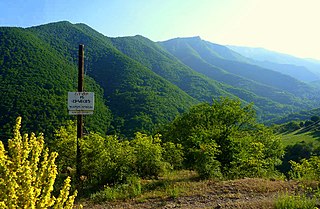
Shikahogh State Reserve is Armenia’s second largest forest reserve, covering some 10,330 ha of land, and located in southern Armenia in the Syunik Province. Environmentalists have said it has been largely unaffected by Armenia’s massive post-Soviet deforestation due to its remote location and care shown by residents of nearby villages.

Forest dieback is a condition in trees or woody plants in which peripheral parts are killed, either by pathogens, parasites or conditions like acid rain, drought, and more. These episodes can have disastrous consequences such as reduced resiliency of the ecosystem, disappearing important symbiotic relationships and thresholds. Some tipping points for major climate change forecast in the next century are directly related to forest diebacks.

Climate change has adversely affected terrestrial and marine ecosystems, including tundras, mangroves, coral reefs, and caves. Increasing global temperature, more frequent occurrence of extreme weather, and rising sea level are examples of the most impactful effects of climate change. Possible consequences of these effects include species decline and extinction and overall significant loss of biodiversity, change within ecosystems, increased prevalence of invasive species, loss of habitats, forests converting from carbon sinks to carbon sources, ocean acidification, disruption of the water cycle, increased occurrence and severity of natural disasters like wildfires and flooding, and lasting effects on species adaptation.
Forest pathology is the research of both biotic and abiotic maladies affecting the health of a forest ecosystem, primarily fungal pathogens and their insect vectors. It is a subfield of forestry and plant pathology.

Glenea is a genus of longhorn beetles belonging to the family Cerambycidae, subfamily Lamiinae.
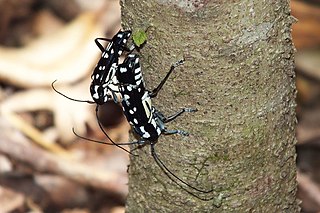
Glenea venus is a species of beetle in the family Cerambycidae. It was described by James Thomson in 1865. It is known from Papua New Guinea, Australia and Indonesia.
Glenea taeniata is a species of beetle in the family Cerambycidae. It was described by James Thomson in 1860. It is known from Malaysia, Borneo and Sumatra.
Glenea algebraica is a species of beetle in the family Cerambycidae. It was described by James Thomson in 1857. It is known from Borneo, Malaysia, Java and Sumatra.
Glenea chlorospila is a species of beetle in the family Cerambycidae. It was described by Charles Joseph Gahan in 1897. It is known from Taiwan and Japan.
Glenea glaucescens is a species of beetle in the family Cerambycidae. It was described by Per Olof Christopher Aurivillius in 1903 and is known from Sulawesi.
Glenea jordani is a species of beetle in the family Cerambycidae. It was described by Lepesme and Stephan von Breuning in 1952.

Glenea elegans is a species of beetle in the family Cerambycidae. It was described by Guillaume-Antoine Olivier in 1795, originally under the genus Saperda. It is known from Malaysia, Thailand, Sumatra, and Java.
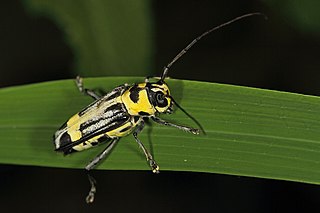
Glenea caninia is a species of beetle in the family Cerambycidae. It was described by Heller in 1926 on the basis of a specimen obtained from Karwar by T.R.D. Bell. It is known from peninsular India in the Western Ghats and associated mountain forests.
Glenea exculta is a species of beetle in the family Cerambycidae. It was described by Newman in 1842.











